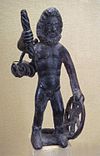- Coventina
-
Coventina was a Romano-British goddess of wells and springs. She is known from multiple inscriptions at one site in Northumberland county of the United Kingdom, an area surrounding a wellspring near Carrawburgh on Hadrian's Wall. It is possible that other inscriptions, two from Hispania and one from Narbonensis, refer to Coventina, but this is uncertain and disputed.[1]
Contents
Location and dating
Dedications to Coventina and votive deposits were found in a walled area which had been built to contain the outflow from a spring now called "Coventina's Well". The well and the walled area surrounding it are nearby the site variously referred to as Procolita, Brocolitia, or Brocolita, once a Roman fort and settlement on Hadrian's Wall, now known as Carrawburgh.[2] The remains of a Roman Mithraeum and Nymphaeum are also found near the site.
The site near Coventina's Well was excavated by British archaeologist, John Clayton, in 1876.[3] The date of the wall at Coventina's Well is uncertain, but some have theorized that it was built sometime after the completion of the Roman fort (dated between the years 128 and 133). Since Hadrian's Wall does not deviate to avoid the well, this may suggest that the boundary wall around the well was built some time after in order to control the flow of water in a marshy area.[4]
Evidence from coin hoards and stones which covered them and those also blocking the well suggest a fairly abrupt end around 388, perhaps due to events linked to anti-Pagan edicts of Theodosius I.
Statues
Excavation of the site revealed several inscribed altars, some with depictions of Coventina in typical Roman nymph form; two are shown here. On one, Coventina is depicted in triple form, or alternatively has two attendants.
Excavation also revealed a large quantity of coinage, from early Augustan coins to those of the late 4th century, and other votive objects such as brooches, rings, pins, glassware, and pottery. These are assumed to be votive offerings due to the quantity discovered in a single location.
Inscriptions
At least ten inscriptions to Coventina are recorded from Carrawburgh. Several stone altars contained dedications to Coventina, as did two pottery incense burners.
The inscription (RIB 1534) on the image of the single Coventina illustrated above reads
- Deae Cov{v}entinae /
- T D Cosconia /
- nvs Pr Coh /
- I Bat L M
“To the Goddess Coventina, Titus D[unclear] Cosconianus, Prefectus of the First Cohort of Batavians, freely and deservedly (dedicated this stone).”
Three altars dedicated to Mithras were placed there by the Prefects of the military garrison.
Literary References
In his book The Skystone, Jack Whyte represents Coventina as the inspiration for The Lady of the Lake. In Seamus Heaney's poem "Grotus and Conventina" from his 1987 collection 'The Haw Lantern'
References
- ^ L. Allason-Jones and B. McKay, Coventina's Well, Oxbow Books/The Trustees of the Clayton Collection, Chester Museum. Oxford, UK, 1985
- ^ The name "Procolita" is found in the 5th century document Notitia Dignitatum, and "Brocolita" in the 7th century Ravenna Cosmography.
- ^ Many of the artifacts recovered by John Clayton are preserved in the "Clayton Collection" currently currated by English Heritage at Chesters Museum
- ^ Op. cit. Allason-Jones and McKay
- Allason-Jones, Linday & McKay, Bruce (1985) Coventina's Well, a shrine on Hadrians Wall. Trustees of the Clayton Collection, Chesters Museum. ISBN 0-946897-05-0
- Collingwood, R.G. and Wright, R.P. (1965). The Roman Inscriptions of Britain (RIB). Oxford, Clarendon Press. Available online
External links
- tehomet.net has historical, archaeological, folkloric, theological and literary resources for Coventina, plus photographs of the archaeological site and the artifacts found there. Also includes directions to the site and associated museum.
- Brocolita at Roman-Britain.org
Celtic mythology series Ancient deities of Gaul, Britain and Gallaecia by region Supra-regional Alaunus • Alisanos • Andarta • Anextiomarus • Artio • Aveta • Belenus • Belisama • Borvo • Brigantia • Camulus • Cernunnos • Cicolluis • Cissonius • Condatis • Damona • Matrona • Dis Pater • Epona • Erecura • Esus • Genii Cucullati • Grannus • Ialonus Contrebis • Lenus • Litavis • Loucetios • Lugus • Maponos • Matres • Mogons • Nantosuelta • Ogmios • Rosmerta • Segomo • Sirona • Sucellus • Suleviae • Taranis • Toutatis • Virotutis • VisuciusBritannia Gallia Aquitania Gallia Belgica Abnoba • Ancamna • Arduinna • Arvernus • Icovellauna • Inciona • Intarabus • Iovantucarus • Ritona • Veraudunus • Vindonnus • Vosegus • XulsigiaeGallia Celtica Gallia Cisalpina Gallia Narbonensis Germania Inferior Gallaecia Categories: Ancient Gaulish and British goddesses | Sea and river goddesses
Wikimedia Foundation. 2010.




